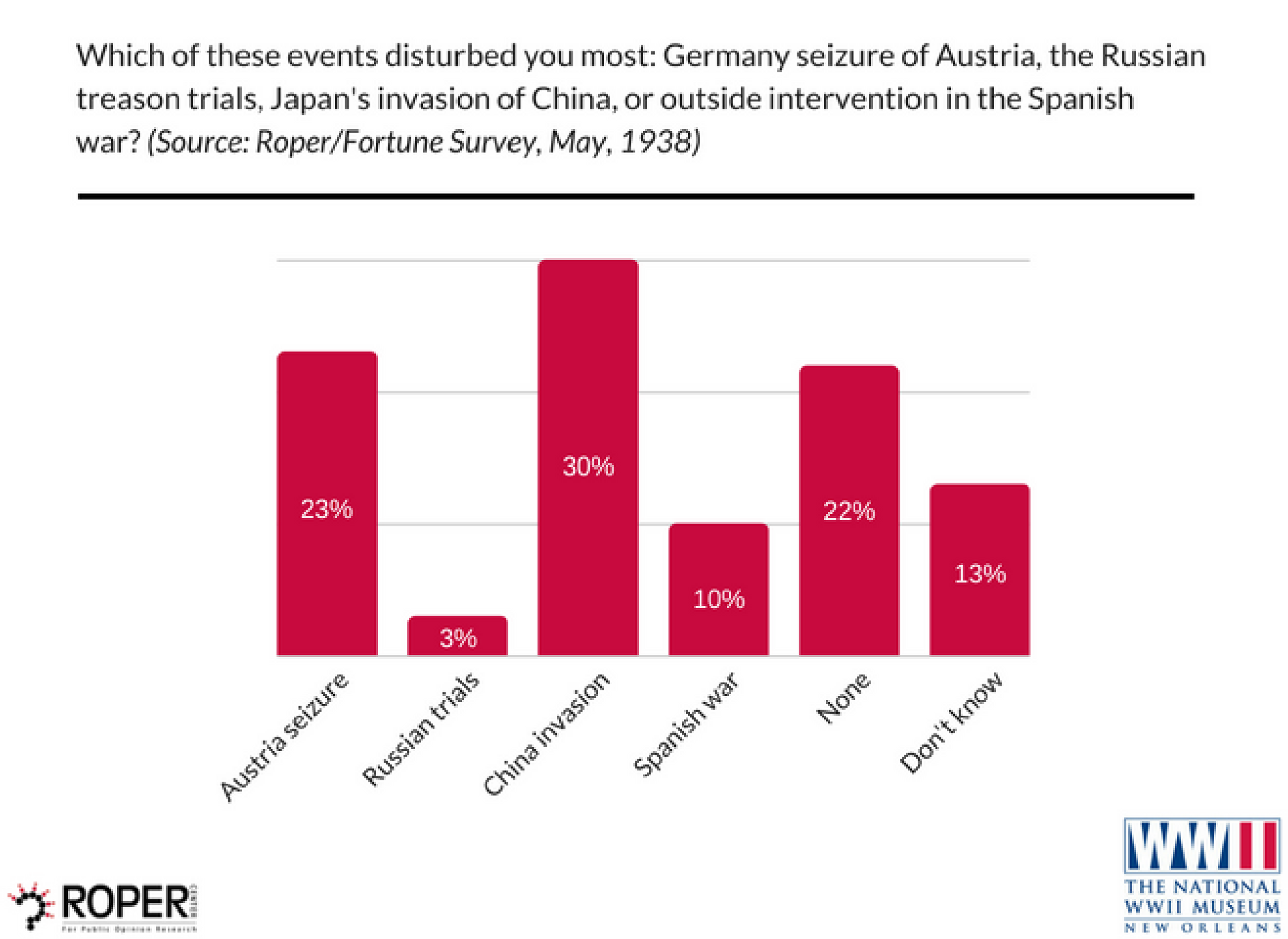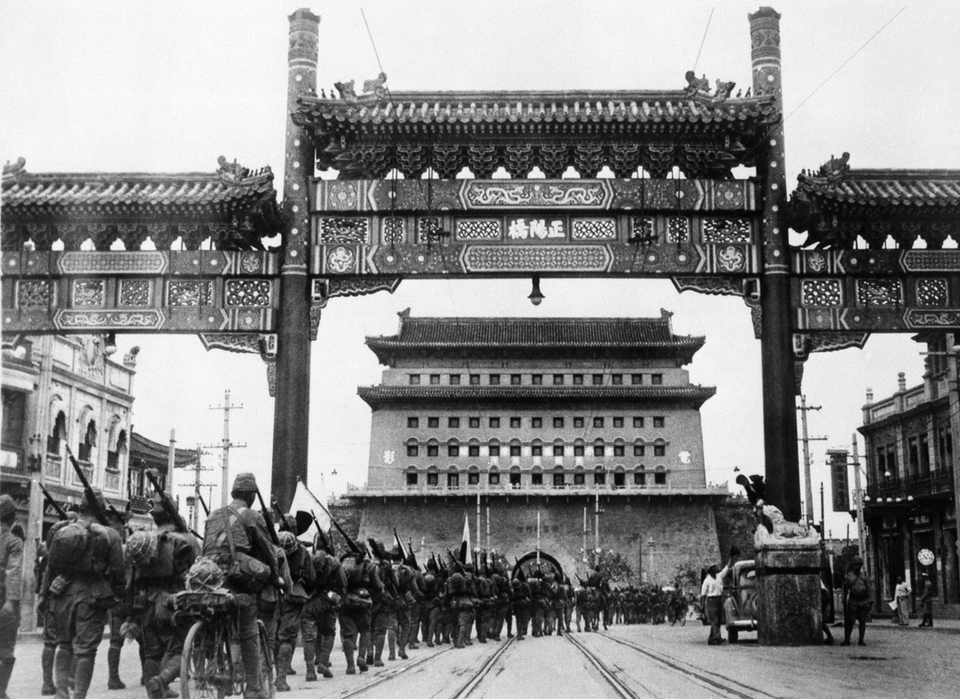Primary image: First pictures of the Japanese occupation of Peiping (Beijing) in China, on August 13, 1937. Associated Press Photo.
Background:
In May of 1938, Americans were mainly concerned with domestic affairs. The depression was not really over, and so understandably most Americans sought ways to provide for themselves and their families. Yet around the world, alarming events were taking place. Starting with the orchestration of the murder of a potential political rival, Sergei Kirov, in 1934, Joseph Stalin launched a series of purges and show trials across the Soviet Union. These purges and trials put millions of Soviet citizens in the infamous Gulag system, while many more were simply executed. With a stroke of the pen on Order 00447, Stalin sent millions of alleged “enemies of the people” to their death. The real purpose was to eliminate even possible future objections to any of Stalin’s wishes. The results were total, unquestioned power in Stalin’s hands that lasted until his death in 1953.
In the same time frame, Adolf Hitler invaded neighboring Austria on March 12th, 1938 and shortly after forced a carefully supervised popular vote that favored unification with Nazi Germany with a robust 99.7% in favor. The Anschluss was clearly an act of naked aggression. However, Americans were of many minds about the Nazi sweep to power in 1938. Many simply wanted to stay out of Europe’s wars with major economical concerns at home and memories of WWI in mind. At this time, some prominent Americans, such as Charles Lindberg, spoke favorably of Nazi Germany, and there were even pro-Nazi groups like the German American Bund openly advocating for friendship with Hitler’s regime. Though only some 25,000 German-Americans joined the Bund, German-Americans were the largest population group in America, though most had no contact with the old country by the 1930s. President Franklin Roosevelt had spoken about the dangers of war since 1937; America had yet to seriously consider war with Germany. This decision came only in the wake of Pearl Harbor, when Hitler declared war on the United States on December 11, 1941.
On July 7, 1937, war broke out between Japan and China at the Lugouqiao bridge (Marco Polo bridge) on the outskirts of Beijing. This was the latest part of a longer conflict, with Japan having occupied Manchuria, the home of the last Chinese Emperors in 1910 along with annexing the Chinese protectorate of Korea. Japan had also tested its powerful modernized military with an attack on Shanghai in 1932. The battle presaged the brutality that characterized Japanese operations in China—civilians were killed and residential neighborhoods destroyed indiscriminately. The devastation was difficult to fathom: once the war began, Japanese forces began systematically murdering Chinese civilians. This violence reached its peak in Nanjing in early 1938—more than 20,000 women were raped and put to the bayonet afterwards, along with the 90,000 remaining Chinese troops in the city who had surrendered. This was the beginning of a war that took the life of untold millions of Chinese civilians.
American interests in China went back to the mid-19th century when American merchants and missionaries came to the newly opened treaty port cities to seek commerce and converts. By the 1930s, some 60,000 foreigners lived in Shanghai’s foreign quarter, many of them American. American leaders maintained a strong alliance with Chiang Kai Shek’s nationalist government, with strong ties to the brilliant and charismatic first lady of China, Soong Mei Ling. Though Chinese Americans faced considerable discrimination (such as being prohibited from becoming naturalized citizens by law), more than 100,000 appeared on the 1930 census. By 1938, America had strong business interests in China, but also a long track record of racism towards Chinese people.
One year before war broke out in China, Spain had erupted into civil war between leftist Republican forces with Soviet and international backing and militaristic Nationalist forces with Nazi and Italian Fascist support. Republican forces included an Abraham Lincoln Battalion whose ranks included writer Ernest Hemingway. Many other literary figures, including Langston Hughes and John Dos Passos, also spent time with Republican forces during the war. In the US less than 200,000 Spanish immigrants lived in the country at the time the war broke out in 1936, making them a tiny fraction of the overall US population in the World War II era. Officially, America remained neutral in the conflict and ordered American firms not to sell military equipment to either side in the conflict.
In May 1938, Americans were polled as to which of these four international events most disturbed them.
The Results:

Source: Roper/Fortune, May 1938. Roper Center for Public Opinion Research at Cornell University.
What Happened:
American relations with the Soviet Union remained strained until the Soviet Union fully collapsed in 1992. Though at the time, few Americans took an interest in Stalin’s murderous purges, America fought a long Cold War with the USSR in no small part because it could not trust a country that murdered so many of its own without cause. During World War II, the USSR and USA became allies of necessity to defeat Nazi Germany and Japanese Imperialism. American forces fought as Soviet allies, and the US sent massive military aid to Russian forces as part of the Lend-Lease program. Shortly after the war ended, the USSR’s military leader during WWII, Marshal Georgy Zhukov observed that “it can't be denied that the Americans gave us so many goods without which we wouldn't have been able to form our reserves and continue the war." All told, America provided over 44,000 jeeps, more than 14,000 airplanes, over 375,000 trucks, nearly 13,000 tanks and huge stores of fuel and food to the beleaguered Russians, who bore the vast majority of Germany’s war effort from 1941-1944. After the war ended, US-USSR relations quickly deteriorated to a series of proxy wars from 1946 well into the 1980s.
America’s response to German aggression is well known. President Roosevelt began urging the country to prepare for war in 1937. He convinced the Congress to authorize Lend-Lease in March 1941, providing direct aid not only to the USSR but also to the United Kingdom, the Free French, Nationalist China and other allies. Our own forces also grew rapidly, from 174,000 in July 1939 to more than sixteen million serving by the war’s end. Hitler’s declaration of war on the United States three days after Pearl Harbor made any further arguments by America First or other non-intervention groups irrelevant. American forces joined the Allied Powers to defeat Nazi Germany in May of 1945. Not long after the war, West Germany became a key American ally.
America’s role in China has been a complex story but in the short run, after 1938, Nationalist China received American aid and volunteer forces in the form of General Claire Chennault’s Flying Tigers. America as a whole was appalled by the news coming out of China, as shown by this poll and others. American forces joined the Nationalists in fighting Japan in December 1941 in the wake of Pearl Harbor. America chose not to directly aid Mao Zedong’s smaller communist forces but provided a modest degree of direct aid to Chiang Kai Shek’s forces throughout the war. After the war ended in August 1945, America remained allies with Generalissimo Chiang in the Chinese Civil War that broke out in 1946. However, America did little to aid him and his forces lost decisively in 1949, fleeing to Taiwan.
America remained neutral in the Spanish Civil War, which ended in March of 1939. Nationalist forces under General Francisco Franco entered Madrid and took power on March 28th. Franco remained in power until his death November 1975.

WWII Polls
Public opinion polls give us unique insight into America in the WWII era. Each week, historians from the Institute for the Study of War and Democracy work with the archives of the Roper Center for Public Opinion Research at Cornell University to explore what Americans believed and how they felt about events and people related to the WWII years.
Cite this article:
MLA Citation:
APA Citation:
Chicago Style Citation:




![Max Fuchs, New York City cantor, sings as Rabbi Sydney [sic] Lefkowitz, Richmond, VA, conducts the first Jewish services from Germany.](/sites/default/files/styles/max_650x650/public/2025-10/image1.jpg)



